Avro Vulcan B.Mk.2
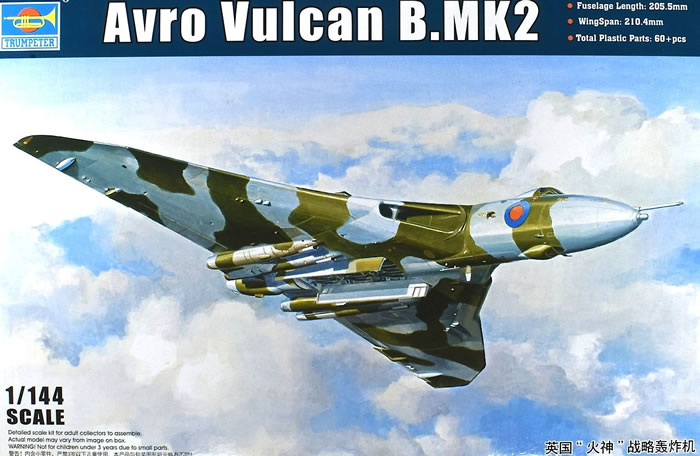
Trumpeter, 1/144 scale
S
u m m a r y : |
Description and Item No.: |
Trumpeter Kit No.03931 - Avro Vulcan B.Mk.2 |
Contents and Media: |
66 parts in grey styrene, two clear parts, and one decal sheet with markings for two airframes. |
Price: |
£32.99 EU Price (£27.49 Export Price) plus shipping from Hanants |
Scale: |
1/144 |
Review Type: |
First Look |
Advantages: |
Simple, straightforward build with nicely recessed surface details. |
Disadvantages: |
The kit has some rectifiable issues with regards to specific variants and weaponry. |
Recommendation: |
I’m pretty happy with my Trumpeter Vulcan. It looks like a nice easy build (other than painting all those wheels) and appears to capture the complex shape of the batwing bomber. But I keep being struck by the notion that the kit is a tad overpriced. Maybe I’m just cheap? |
Reviewed by Jim Bates

Airfix's 1/72 scale Sea King is available online from Squadron.com
As a young boy attending the many wonderful airshows in Southern Ontario there were two jets that always took my breath away; the CF-101 Voodoo and the Avro Vulcan. They were both large impressive aircraft with loud reverberating engines. Of the two, though, it was the Vulcan that made the biggest impression. A large manta ray looking delta, it was the bomber that performed like a fighter. I can still remember the howl from its four Olympus engines.
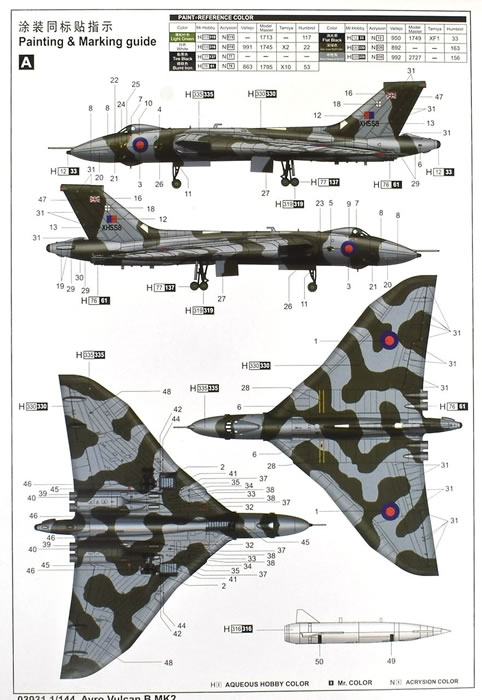
Combine that with Vulcan’s appearance in “Thunderball,” it quickly took the place as my favorite jet bomber. V Force indeed; what a totally awesome airplane, dude. Then stories emerged about the Black Buck raids in the Falklands and it further cemented its place in my mind as one impressive bomber. Not long after the Falkland War, the Vulcan was retired from service. A private Vulcan (XH558) performed at airshows from 2008 until 2015, but since then the skies have been, sadly, Vulcan free.
The Vulcan in Scale:
Until recently, the only injection-modeled kit of the Vulcan was by Airfix released shortly after the Falklands War in 1983. While praised at the time, its breakdown means that it takes some work to get the wings and fuselage together without visible seams. Airfix will address this later in the year with a new tool 1/72 Vulcan coming in 2020. Recently, Cyber-hobby released a 1/200 scale Vulcan and Great Wall released one in 1/144. Neither of those kits ever crossed my bench, but a few weeks back I was walking into Skyway Hobby my local hobby shop in Renton, Washington, and what was on the new release wall? Another 1/144 Vulcan, this time by Trumpeter. Sure the price was kinda high for a small bomber, but it was a Vulcan and I HAD to buy it.
The kit includes two large plastic sprues in grey plastic, a smaller grey plastic sprue, and a tiny clear runner with the canopy and the bomb aimers window. First impressions are of the large fuselage/wing moldings, no issues with wing to fuselage joints as in the Airfix kit. Second impressions are of the fine recessed surface detail: very nice.
One bummer is that even though the bomb bay is depicted on the box art, the only option is to either fit the Blue Steel missile or closed bomb doors (more on the former later).
At first glance the kit appears to be inspired by the Airfix kit, but with huge jumps in engineering. As stated previously, the fuselage and wings are split top and bottom in two large pieces.
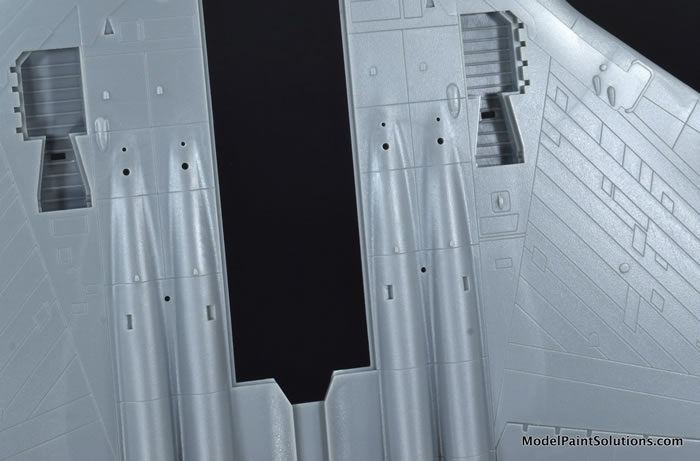
The vertical stabilizer and rear fuselage are again in two pieces, but done in more traditional halves.
The cockpit consists of two ejection seats, a floor, and an instrument panel with a decal for the instruments. One interesting note on the instrument panel is that holes are provided for control columns, but none are provided in the kit. Maybe a little bit of stretched sprue would suffice? As the Vulcan cockpit is small…I remember even as a small child the crew area was claustrophobic…and painted black, the kit detail should suffice.
After cementing the cockpit and the three-part per side intakes, the large fuselage pieces can be assembled. Once the tail and bomb bay blanking plate are added, it is only a matter of adding the complex landing gear and tiny wheels…all eighteen of them, the engine exhausts (which are impressive slide modeled parts with fans just visible), the clear canopy, IFR probe, and various antenna and your Vulcan is complete. (The landing gear doors are flat, but there is some detail inside the bays.)
The two clear parts are for the crew area dome with the side windows.
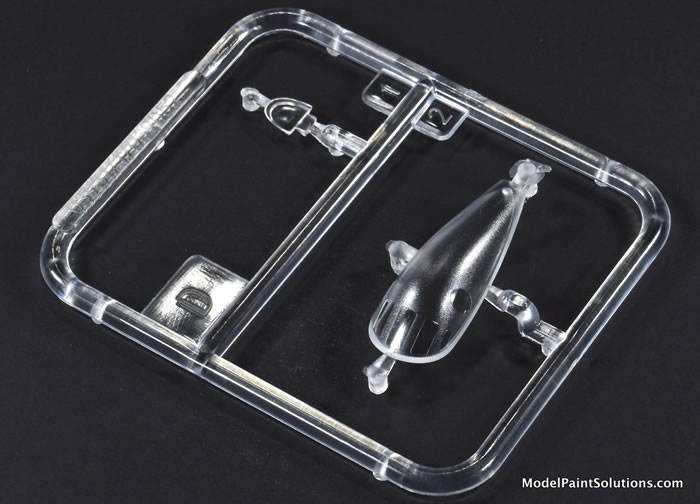
The windscreen is done in clear while the rest of the part is frosted.
Issues:
Why do I think the Airfix Vulcan inspired this kit? Because it carries over at least two odd characteristics of that kit starting with the two ECM plates between the engine nacelles. Only a few aircraft carried both plates and even so only for two or three years in the 1960s. Generally only the right wing plate was carried on later Vulcans. The second odd characteristic is that the fin is molded with the integral RWR receiver. This was added in the mid 70s and would not be fitted to any aircraft carrying the Blue Steel missile. The Airfix kit explained that one needed to carve off that part of the fin for the overall white aircraft they provided decals for. So, out of the box, this aircraft cannot be built as a Blue Steel V-Force Vulcan. However, with some reasonable surgery, the nice three part Blue Steel missile can be fitted and your bomber painted anti-flash white.
The other potential problem with this kit is that it appears that Trumpeter could not decide if their model was fitted with Olympus 200 or 300 series exhaust pipes. The examples in the kit pretty much split the difference between the two. It doesn’t bother me enough to change them, but it is a trap for those that believe every little detail counts.
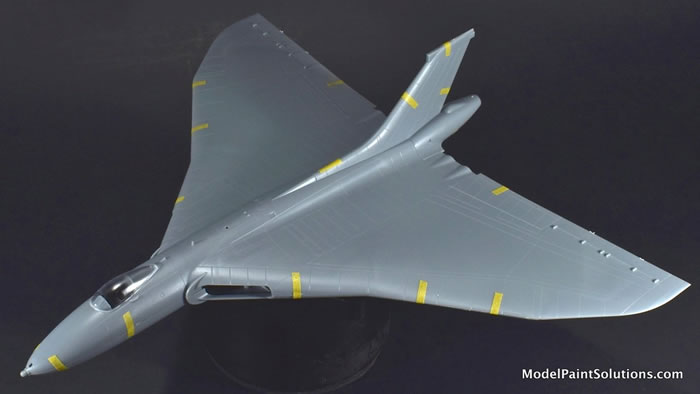
Finally, the tiny side windows on the fuselage are represented by scribed circles. The fastidious will want to drill them out and glaze them in some manner. Also, the kit does not provide the underwing pylons for the Skyflash missiles. These were later re-activated during the Falklands for use with ECM pods and Shrike missiles. Again, no Skylashes, ECM pods, or Shrikes are included in the kit.
Color and Markings:
Decals look like a normal Trumpeter offering--a little glossy, a little sketchy in coloring, and in my example, with slightly out of register fin flashes. I will be ordering replacement sheet from my friends over at Fundekals who do a great sheet covering all Vulcan schemes.
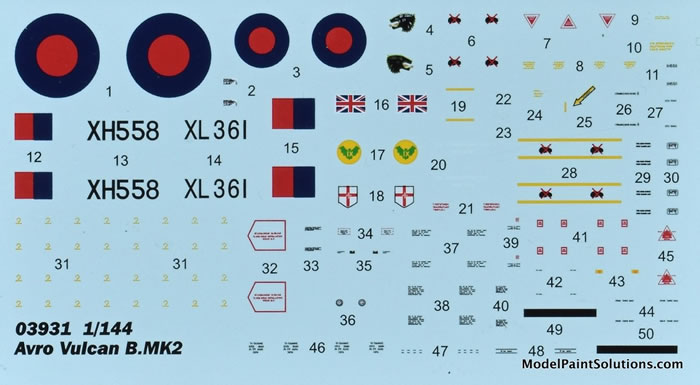
Markings are provided for XH588 in the two-tone Dark Green/Dark Sea Grey paint scheme and XL361 of 9 “B” Squadron RAF in the three tone Dark Green/Medium Sea Grey over Light Aircraft Grey scheme. (B for bomber, not bat, but either way works.) Oddly, both markings pages include instructions to add decals to the Blue Steel even though neither aircraft carried the weapon.
I’m pretty happy with my Trumpeter Vulcan. It looks like a nice easy build (other than painting all those wheels) and appears to capture the complex shape of the batwing bomber. But I keep being struck by the notion that the kit is a tad overpriced. Maybe I’m just cheap?
Kit purchased by reviewer.
Thanks to John Miller of Model Paint Solutions for taking the photos used in this article.
For more on this review visit Modelpaintsolutions.com.
Review Text Copyright © 2020 by Jim Bates
Images Copyright © 2020 by John Miller
Page Created 24 March, 2020
Last updated
24 March, 2020
Back to HyperScale Main Page
Back to Reviews Page

|
Home
| What's New |
Features |
Gallery |
Reviews |
Reference |
Forum |
Search